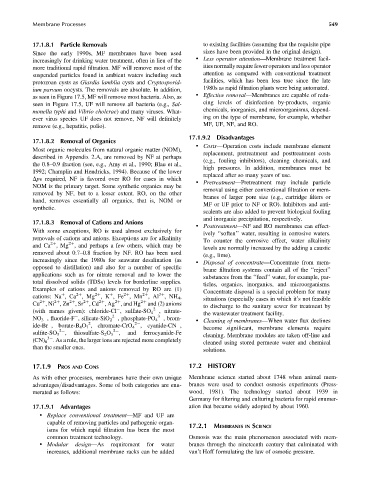Page 594 - Fundamentals of Water Treatment Unit Processes : Physical, Chemical, and Biological
P. 594
Membrane Processes 549
17.1.8.1 Particle Removals to existing facilities (assuming that the requisite pipe
Since the early 1990s, MF membranes have been used sizes have been provided in the original design).
. Less operator attention—Membrane treatment facil-
increasingly for drinking water treatment, often in lieu of the
more traditional rapid filtration. MF will remove most of the ities normally require fewer operators and less operator
suspended particles found in ambient waters including such attention as compared with conventional treatment
protozoan cysts as Giardia lamblia cysts and Cryptosporid- facilities, which has been less true since the late
ium parvum oocysts. The removals are absolute. In addition, 1980s as rapid filtration plants were being automated.
. Effective removal—Membranes are capable of redu-
as seen in Figure 17.5, MF will remove most bacteria. Also, as
seen in Figure 17.5, UF will remove all bacteria (e.g., Sal- cing levels of disinfection by-products, organic
chemicals, inorganics, and microorganisms, depend-
monella typhi and Vibrio cholerae) and many viruses. What-
ever virus species UF does not remove, NF will definitely ing on the type of membrane, for example, whether
remove (e.g., hepatitis, polio). MF, UF, NF, and RO.
17.1.9.2 Disadvantages
17.1.8.2 Removal of Organics
. Costs—Operation costs include membrane element
Most organic molecules from natural organic matter (NOM),
replacement, pretreatment and posttreatment costs
described in Appendix 2.A, are removed by NF at perhaps
(e.g., fouling inhibitors), cleaning chemicals, and
the 0.8–0.9 fraction (see, e.g., Amy et al., 1990; Blau et al.,
high pressures. In addition, membranes must be
1992; Champlin and Hendricks, 1994). Because of the lower
replaced after so many years of use.
Dps required, NF is favored over RO for cases in which
. Pretreatment—Pretreatment may include particle
NOM is the primary target. Some synthetic organics may be
removal using either conventional filtration or mem-
removed by NF, but to a lesser extent. RO, on the other
branes of larger pore size (e.g., cartridge filters or
hand, removes essentially all organics, that is, NOM or
MF or UF prior to NF or RO). Inhibitors and anti-
synthetic.
scalents are also added to prevent biological fouling
and inorganic precipitation, respectively.
17.1.8.3 Removal of Cations and Anions
. Posttreatment—NF and RO membranes can effect-
With some exceptions, RO is used almost exclusively for
ively ‘‘soften’’ water, resulting in corrosive waters.
removals of cations and anions. Exceptions are for alkalinity
To counter the corrosive effect, water alkalinity
and Ca ,Mg , and perhaps a few others, which may be levels are normally increased by the adding a caustic
2þ
2þ
removed about 0.7–0.8 fraction by NF. RO has been used
(e.g., lime).
increasingly since the 1980s for seawater desalination (as . Disposal of concentrate—Concentrate from mem-
opposed to distillation) and also for a number of specific
brane filtration systems contain all of the ‘‘reject’’
applications such as for nitrate removal and to lower the
substances from the ‘‘feed’’ water, for example, par-
total dissolved solids (TDSs) levels for borderline supplies.
ticles, organics, inorganics, and microorganisms.
Examples of cations and anions removed by RO are (1)
Concentrate disposal is a special problem for many
cations: Na ,Ca ,Mg ,K ,Fe ,Mn ,Al ,NH 4 ,
2þ
2þ
þ
2þ
þ
3þ
2þ
situations (especially cases in which it’s not feasible
Cu ,Ni ,Zn ,Sr ,Cd ,Ag , and Hg 2þ and (2) anions
2þ
2þ
2þ
2þ
2þ
2þ
to discharge to the sanitary sewer for treatment by
(with names given): chloride-Cl , sulfate-SO 4 , nitrate-
2
the wastewater treatment facility.
NO 3 , fluoride-F , silicate-SiO 2 , phosphate-PO 4 , brom- . Cleaning of membranes—When water flux declines
2
3
2
ide-Br , borate-B 4 O 7 , chromate-CrO 4 , cyanide-CN ,
2
become significant, membrane elements require
sulfite-SO 3 , thiosulfate-S 2 O 3 , and ferrocyanide-Fe
2
2
cleaning. Membrane modules are taken off-line and
(CN) 6 . As a rule, the larger ions are rejected more completely
3
cleaned using stored permeate water and chemical
than the smaller ones.
solutions.
17.1.9 PROS AND CONS 17.2 HISTORY
As with other processes, membranes have their own unique Membrane science started about 1748 when animal mem-
advantages=disadvantages. Some of both categories are enu- branes were used to conduct osmosis experiments (Press-
merated as follows: wood, 1981). The technology started about 1939 in
Germany for filtering and culturing bacteria for rapid enumer-
17.1.9.1 Advantages ation that became widely adopted by about 1960.
. Replace conventional treatment—MF and UF are
capable of removing particles and pathogenic organ-
17.2.1 MEMBRANES IN SCIENCE
isms for which rapid filtration has been the most
common treatment technology. Osmosis was the main phenomenon associated with mem-
. Modular design—As requirement for water branes through the nineteenth century that culminated with
increases, additional membrane racks can be added van’t Hoff formulating the law of osmotic pressure.

